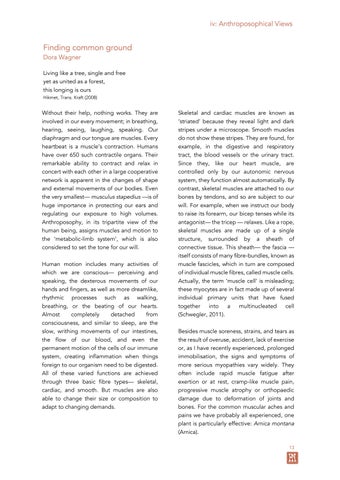iv: Anthroposophical Views
Finding common ground Dora Wagner Living like a tree, single and free yet as united as a forest, this longing is ours Hikmet, Trans. Kraft (2008)
Without their help, nothing works. They are involved in our every movement; in breathing, hearing, seeing, laughing, speaking. Our diaphragm and our tongue are muscles. Every heartbeat is a muscle’s contraction. Humans have over 650 such contractile organs. Their remarkable ability to contract and relax in concert with each other in a large cooperative network is apparent in the changes of shape and external movements of our bodies. Even the very smallest— musculus stapedius —is of huge importance in protecting our ears and regulating our exposure to high volumes. Anthroposophy, in its tripartite view of the human being, assigns muscles and motion to the ‘metabolic-limb system’, which is also considered to set the tone for our will. Human motion includes many activities of which we are conscious— perceiving and speaking, the dexterous movements of our hands and fingers, as well as more dreamlike, rhythmic processes such as walking, breathing, or the beating of our hearts. Almost completely detached from consciousness, and similar to sleep, are the slow, writhing movements of our intestines, the flow of our blood, and even the permanent motion of the cells of our immune system, creating inflammation when things foreign to our organism need to be digested. All of these varied functions are achieved through three basic fibre types— skeletal, cardiac, and smooth. But muscles are also able to change their size or composition to adapt to changing demands.
Skeletal and cardiac muscles are known as ‘striated’ because they reveal light and dark stripes under a microscope. Smooth muscles do not show these stripes. They are found, for example, in the digestive and respiratory tract, the blood vessels or the urinary tract. Since they, like our heart muscle, are controlled only by our autonomic nervous system, they function almost automatically. By contrast, skeletal muscles are attached to our bones by tendons, and so are subject to our will. For example, when we instruct our body to raise its forearm, our bicep tenses while its antagonist— the tricep — relaxes. Like a rope, skeletal muscles are made up of a single structure, surrounded by a sheath of connective tissue. This sheath— the fascia — itself consists of many fibre-bundles, known as muscle fascicles, which in turn are composed of individual muscle fibres, called muscle cells. Actually, the term ‘muscle cell’ is misleading; these myocytes are in fact made up of several individual primary units that have fused together into a multinucleated cell (Schwegler, 2011). Besides muscle soreness, strains, and tears as the result of overuse, accident, lack of exercise or, as I have recently experienced, prolonged immobilisation, the signs and symptoms of more serious myopathies vary widely. They often include rapid muscle fatigue after exertion or at rest, cramp-like muscle pain, progressive muscle atrophy or orthopaedic damage due to deformation of joints and bones. For the common muscular aches and pains we have probably all experienced, one plant is particularly effective: Arnica montana (Arnica). 13
